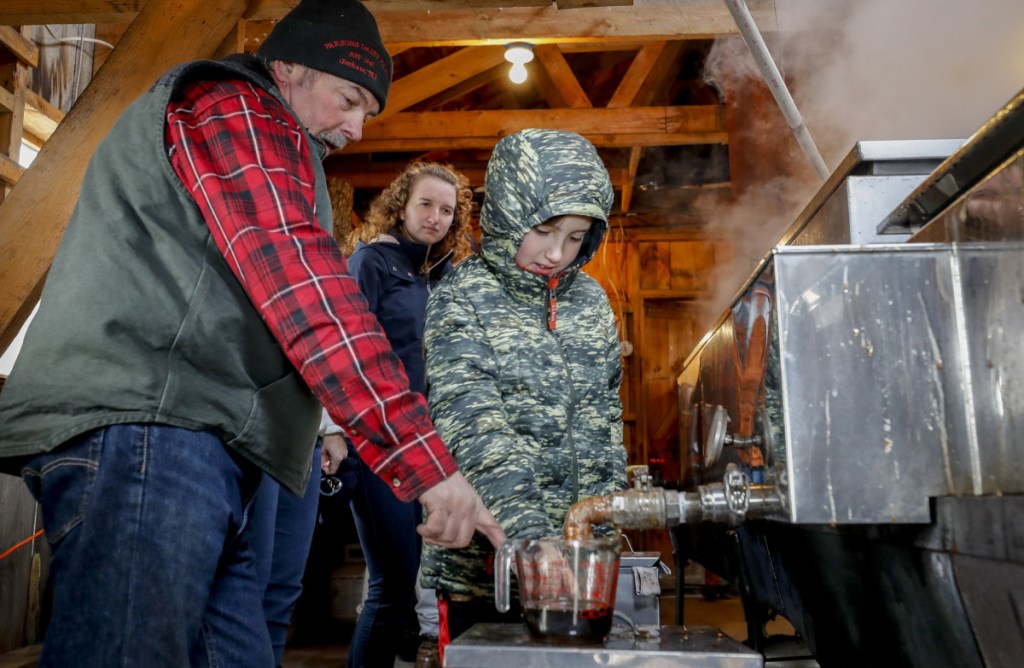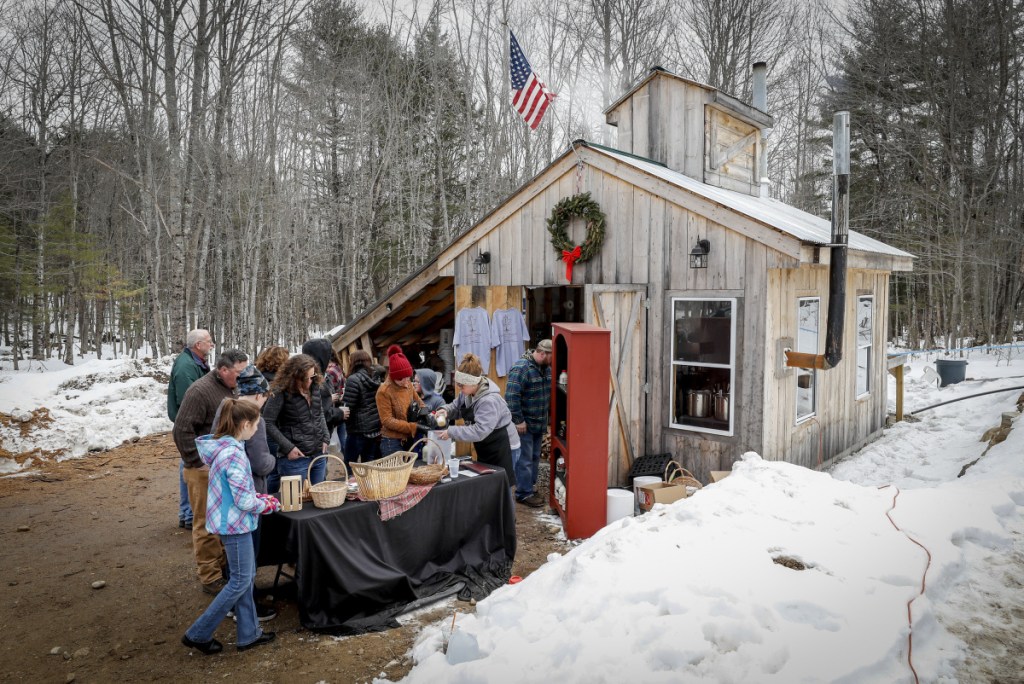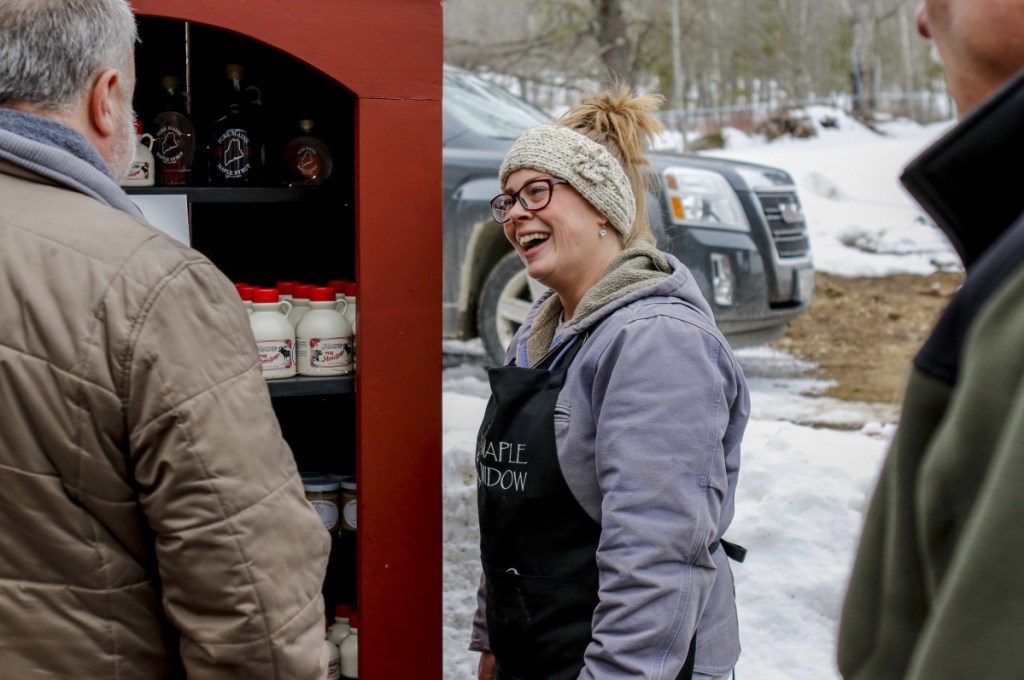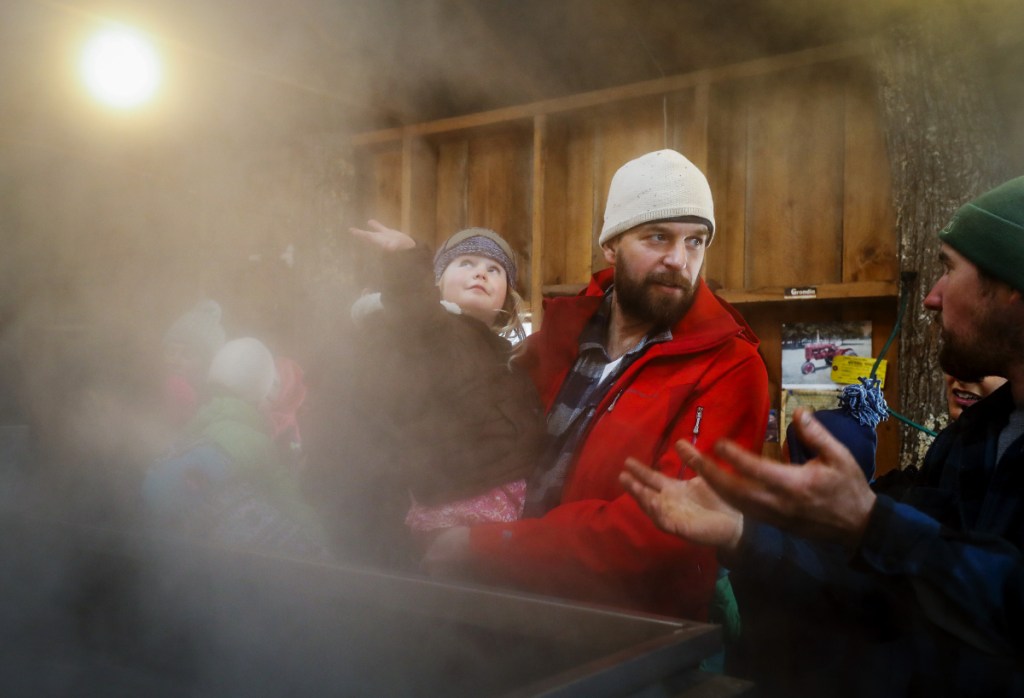GORHAM — The amber liquid is bubbling hard, churning up sweet-scented steam that billows from the 100-gallon stainless steel tank and rises through a hole in the roof of the rustic sugarhouse at Parsons Dairy Farm.
You catch a whiff of maple sap on the boil long before you get there, trudging down the muddy lane, past snow-covered fields, sleepy-eyed cows and yellow farm equipment that’s been resting for a few months now. Mixed with smoke from the wood-fired evaporator, it smells like winter doesn’t want to give up and spring isn’t quite ready to be here.
It’s the 35th annual Maine Maple Sunday and there’s a steady line of people braving just-above-freezing weather so they can tuck in to a plate of syrup-slathered pancakes in the sugarhouse’s small heated dining room. But the real action is happening out back, where Russell Parsons is in his glory, telling visitors how he and his family make Parsons Maple Products.
“It’s hard labor, but I love it,” Parsons says. “It started out as a hobby, something I learned to do as a kid. Something my family has probably always done, going back five generations on this land. Six generations now, with my sons.”
Parsons, 53, was among nearly 100 maple producers across Maine who opened their sugarhouses to the public Sunday for the popular promotional event organized by the Maine Maple Producers Association. People turned out in droves – maple aficionados and the culinarily curious alike – for tours, demonstrations and maple products. Offerings ranged from traditional syrup, candy and ice cream, to more adventurous popcorn, baked beans and herb-infused butters.
Standing beside Parsons, 8-year-old Aiden Abbott of Saco dips a finger into warm syrup just drawn from the evaporator and touches it to his tongue. It’s his first visit to a sugarhouse. His first taste of fresh maple syrup.
“It’s delicious,” he says, smiling.
For Parsons, this is the best part of Maine Maple Sunday.
“I like to see all the kids,” he says. “They get to see how it’s done. They get an appreciation of how much work goes into what we do.”
OFFICIAL MAINE SWEETENER
With nearly 2 million taps on trees across the state, Maine has the third largest maple syrup industry in the United States, after Vermont and New York, according to the Maine Department of Agriculture. The “official sweetener of Maine” has a statewide economic impact of $48.7 million annually, contributing to 805 full- and part-time jobs and generating $25.1 million in labor income.
The season usually lasts four to six weeks, with about 15 good sap flow days. Boiling removes water from the sap and intensifies the sweetness. About 40 gallons of sap will produce 1 gallon of syrup, tested with a hydrometer to reach the perfect density. As the season progresses, syrup often gets darker and more deeply flavored.
At Hidden Roots Maple Farm in Limington, Nick and Abigail Storer are in their second season producing syrup and other treats, so they’re fairly new to the hard work that is familiar to Parsons.
Both in their 30s, they have a 2-year-old son and full-time jobs; he’s a welding supervisor and she’s a medical billing specialist. They worked around the clock in the weeks leading up to their first Maine Maple Sunday. Collecting sap after work and boiling it in their year-old sugarhouse past midnight. Making maple-covered peanuts, popcorn and other treats for sale.
“We made everything in our kitchen,” Abigail Storer says. “You should see my house right now.”
Nick Storer learned how to make maple syrup as a kid, working in local sugarhouses. As an adult, he started tapping trees as a hobby, then decided to get serious. He tapped 145 trees last year and 320 trees this year, doubling production from 33 gallons of syrup in 2017 and 66 gallons so far in 2018.
“I haven’t slept in a month and a half,” he says. “But I’ll do it all over again next year. Definitely.”
A FAMILY TRADITION
Parsons Dairy Farm has been participating in Maine Maple Sunday for 24 years. It’s a regular stop for Brittanie Lachance, 30, of Waterboro. She and her family visit a few sugarhouses each year.
“It’s a tradition we started when I was a baby,” Lachance says, surrounded by her two children, a sister and her father.
This year, the season started a little early for Parsons Maple Products and other producers. With a warm stretch in February, Parsons and his son Adam set about drilling 1,400 taps in maple trees across the 600-acre farm. Sons Zack and Isaac also help with maple production, along with other family members.
The goal is to be ready to catch the flow of sap when outdoor temperatures hit sweet spots in the 40s during the day and plummet into the 20s at night. The Parsons family has collected 4,200 gallons of sap so far this year, which has boiled down to about 100 gallons of syrup. They could produce another 80 gallons of syrup this season, if Mother Nature cooperates with suitably not-too-warm days and cold nights.
“The season is totally weather-related,” Parsons says. “When we lose the freeze at night, it’s over. After that, the trees start to put out buds.”
By this time next year, tap holes drilled in healthy trees will be healed over, Parsons says. Maple producers have taken steps in recent years to increase the sustainability of their industry, such as reducing the diameter of drill bits to ensure tap holes heal over.
“We drill a smaller hole and get the same volume,” Parsons says.
Buying local, sustainably harvested products is increasingly important to people like Julia Marquis, 18, of Saco. She’s studying environmental science and business at Hartwick College in New York. She was at the Parsons sugarhouse Sunday.
“I’m definitely big on being sustainable,” Marquis says. “It really makes me happy to see how this happens. It’s borrowing a little from Mother Nature without destroying it.”
Send questions/comments to the editors.










Comments are no longer available on this story